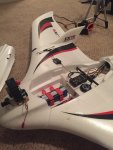BS projects inc.
Elite member
For the last few months I have been cruising around with my Zohd Nano talon with an fpv setup that got me half a mile away. Over the weekend however, the plane and fpv setup stopped working, after it was run over by a plow. The esc burnt out (I was using the recommended voltage) and it glided right in front of a tractor and got churned up into bits and pieces. The receiver, battery, and servos were fine and it was on our property, so no real damage. But the event inspired me upgrade my platform. I have had this fx-79 for about a month now with the intention to turn it into an fpv platform with an autopilot on it. I have done a ton of reading about pixhawk boards so I ordered one and for the last week I have been having a blast exploring every possible function of it. I have all of my electronics tuned in and I am ready to mount everything to the plane. However, what I thought was going to be the easy part has been more difficult than anticipated. Right now I need to mount a gps, fpv system, and LRS (r9m 900mhz reciever) and I don't know how I need to space them out. I will put a list of my electronics below but I am struggling with how to plan this.I would like a gopro up front but it's not mandatory but I heard that they can mess up your vtx, and I planned on mounting the vtx about 4-5 inches high up front. The picture shows where I would like to place the camera and vtx on the nose but I am unsure if I need to mount it on the wingtip instead. The vtx receives power through an xt60 connector with a jst connector that runs off of it so it's powered by the main battery.
If I put the vtx on the wingtip I would have to run some pretty long leads to the camera and battery, wouldn't that create more unnecessary interference?
I have also read on the forums that 5.8ghz does not travel through epp foam very well, should I consider mounting it under the wing facing down?


How well would the gps function where it sits currently? I planned on mounting it about 6 inches in the air on the stand it came with.
I also planned on mounting the RC reciever where it sits in the picture, is this enough distance from the other electronics?


Two final questions that don't have pictures to illustrate them. If I mount my vtx or gps on a pole and turbulence forces those poles to vibrate, would those vibrations cause any sort of interference or would the small movements cause issues with vtx or gps? Finally, there is not a single toroid filter on the plane or really any sort of power filter on the plane. How important is it that I put some on and where?
This is my ground station BTW

List of electronics on the frame
Plane: FX-79 Buffalo
RC Transmitter: Taranis QX7 with R9m LRS
RC Receiver: Frsky R9 reciever
VTX: TBS Unify Pro 32
VTX antenna: Foxeer Lolipop mmcx RHCP
Ground Station: Furious FPV Dock King
Video Receiver: Furious FPV True-D V3
Receiver Antennas: Immersion RC spironet patch antenna 8di RHCP and Immersion rc spironet 5.8ghz cloverleaf antenna (Diversity antenna combo)
FPV camera: Foxeer Razer Mini 1200tvl PAl
Flight Controller: Pixhawk PX4 with GPS, current sensor, buzzer, and safety switch
Motor: Durafly Tundra Motor
Prop: 12x6 Carbon Fiber prop, non-folding
UBEC: Hobbyking Skywalker 50amp ubec
Servos: 2x Emax ES08MAII 12g metal gear servo
Battery: 2x 3000mah 3s batteries in parallel
Action Camera: GoPro Hero 5
Any input would be appreciated, thanks!
If I put the vtx on the wingtip I would have to run some pretty long leads to the camera and battery, wouldn't that create more unnecessary interference?
I have also read on the forums that 5.8ghz does not travel through epp foam very well, should I consider mounting it under the wing facing down?


How well would the gps function where it sits currently? I planned on mounting it about 6 inches in the air on the stand it came with.
I also planned on mounting the RC reciever where it sits in the picture, is this enough distance from the other electronics?


Two final questions that don't have pictures to illustrate them. If I mount my vtx or gps on a pole and turbulence forces those poles to vibrate, would those vibrations cause any sort of interference or would the small movements cause issues with vtx or gps? Finally, there is not a single toroid filter on the plane or really any sort of power filter on the plane. How important is it that I put some on and where?
This is my ground station BTW

List of electronics on the frame
Plane: FX-79 Buffalo
RC Transmitter: Taranis QX7 with R9m LRS
RC Receiver: Frsky R9 reciever
VTX: TBS Unify Pro 32
VTX antenna: Foxeer Lolipop mmcx RHCP
Ground Station: Furious FPV Dock King
Video Receiver: Furious FPV True-D V3
Receiver Antennas: Immersion RC spironet patch antenna 8di RHCP and Immersion rc spironet 5.8ghz cloverleaf antenna (Diversity antenna combo)
FPV camera: Foxeer Razer Mini 1200tvl PAl
Flight Controller: Pixhawk PX4 with GPS, current sensor, buzzer, and safety switch
Motor: Durafly Tundra Motor
Prop: 12x6 Carbon Fiber prop, non-folding
UBEC: Hobbyking Skywalker 50amp ubec
Servos: 2x Emax ES08MAII 12g metal gear servo
Battery: 2x 3000mah 3s batteries in parallel
Action Camera: GoPro Hero 5
Any input would be appreciated, thanks!





